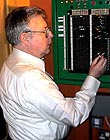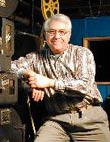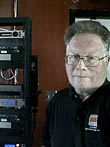|
|
This topic comprises 5 pages: 1 2 3 4 5
|
|
Author
|
Topic: who uses motor-generators?
|
|
|
|
|
|
|
|
|
|
|
|
|
|
|
|
|
|
|
Stephen Furley
Film God

Posts: 3059
From: Coulsdon, Croydon, England
Registered: May 2002
|
 posted 05-10-2003 04:47 PM
posted 05-10-2003 04:47 PM




Some photographs from the Loew's Jersey last year, I hope they don't mind me posting them.

These are the long-disused motor-generator sets, installed in 1929, I would guess that they were used until the early '50s, when the Ashcraft equipment was installed, but there is very little wear on the commutators. Note the open frame of the generators, it would be quite possible to put your arm into the frame while they were running! They are bigger than they look, I think about the same size as the one in Bernards picture. I was quite surprised by the size when I saw them again a couple of weeks ago, I had forgotten how big they were. Restoration and refurbishment work is still taking place, hence the paint!

This is one of the three Ashcraft selenium rectifiers which replaced them. They are installed in the original generator room, the block of concrete on the left is the plinth that the generators are mounted on.
Interestingly, the generator/rectifier room, rewind room, and various other rooms lead directly off the projection box, there is no connecting corridor between them, and the whole lot is reached by a few stairs through a door at the back of the auditorium, the regulations here would not have allowed that in nitrate days. Also, thee is no means to drop the fire shutters from the auditorium; in a British theatre there would have been a small red box on the back wall of the balcony with a wire handle inside for this purpose. These were sometimes mis-used during Saturday morning childrens shows! Even the College where I work had this, despite having been built after nitrate finished, and only ever having 16mm installed. I managed to acquire the b&H 609 carbon arc machines when they were thrown out.
In the rewind room there is a massive film storage cabinet, standing about as tall as me, built in to the room, and vented to the outside, I have never seen anything like that here.

This is one of the Ashcraft Super Core-lite lamps which the rectifiers are supplying, mounted on a FP20. The tall object standing behind the projector is an Ashcraft water cooler.
One last picture

This one shows the Brenographs, note the unusal venting system, rigid ducting, rather than a hood.
Bernard, I wouldn't have recognised you from that photograph!
Many early cinemas used Crossley gas engines, made in Manchester, before mains electricity was available. There is one in the small cinema which has been re-built an the Black Country Museum, in Dudley. The autitorium was gas lit, the house light dimmer being a log rod running the length of the building, just under the roof! I don't know if the projection room was gas lit, presumably the cinematograph act would have put a stop to that, after 1910.
| IP: Logged
|
|
Bernard Tonks
Jedi Master Film Handler

Posts: 619
From: Cranleigh, Surrey, England
Registered: Apr 2001
|
 posted 05-10-2003 07:02 PM
posted 05-10-2003 07:02 PM




Interesting pictures Stephen. The commentators at the Carlton were is almost perfect shape after 41 years since opening in 1927, they really were cared for. I had the luxury of two house engineers who looked after them, as they did with everything else including the screen masking and two sets of curtains. I was only responsible for the projection room. The massive 50-foot deep stage with fly tower was in use for one year only; Paramount Pictures took over the Carlton for cinema only use in 1928. Although no longer used, the stage lighting board had salt water dimmers that still worked, I was shown the batten lighting behind the screen.
Re: Loew’s Jersey Theatre, Never seen two Brenographs in a projection box before, are they in working order? Must go there one day, I visited New York nearly three years ago. Would be great if the Brenograph at the disused State Theatre, Grays could be installed at the Odeon, Leicester Square replacing the old Ross Scenograph.
| IP: Logged
|
|
Stephen Furley
Film God

Posts: 3059
From: Coulsdon, Croydon, England
Registered: May 2002
|
 posted 05-11-2003 06:41 AM
posted 05-11-2003 06:41 AM




Bernard wrote:
quote:
Re: Loew’s Jersey Theatre, Never seen two Brenographs in a projection box before, are they in working order? Must go there one day, I visited New York nearly three years ago. Would be great if the Brenograph at the disused State Theatre, Grays could be installed at the Odeon, Leicester Square replacing the old Ross Scenograph.
Two Brenographs not common; I never saw either place, but I'm told that the Gaumont State, Kilburn had two, and the Gaumont Palace, Lewisham may have done, conflicting reports on that one. The 1929 Brenkert catalogue, available to download from the Film-Tech manuals section, does specify a minimum spacing when two are installed.
The ones at the Loew's are a long way from being usable, I doubt if they have seen use in the last fifty years, but there's nothing that would be impossible, or even very difficult, to put right, given time. The small band of people working on the theatre have achieved much, but there is still a lot of work to be done, so it won't happen overnight.
Basically, the problems are:
The machines are rusty, but it's only surface rust, and would clean up.
Most mechanical parts are seized solid, and will not move, they would need completely stripping down and cleaning.
All sixteen lenses are missing, but most of the retaining clips that held them are still there. I don't think new lenses would be too much of a problem, the people who supply school science labs might have something, even if it meant turning up adapters for slightly smaller lenses, or something.
Some of the condenser lenses are missing, but there are enough to get one machine working.
A few of the twelve mirrors are missing, on all the others the surface has gone, not a major problem to replace.
One section of extraction duct is missing, but could be made. If you lok at the ducting just over the front of the top lantern on the far machine, you can just see a place where one section slides inside another, to allow the lanterns to move.
The large D.C switches have been removed from their housings, but these things can be found.
It's really a question of labour, if I lived a bit nearer, I think I could get one of them working, without too much difficulty, and could probably afford the parts, but I can't exactly nip over there for a few hours in the evenings.
The place is only a few minutes from the centre of New York, the Path trains from Manhattan serve Journal Square station, which is just across the street.
As built, the place was something over 3000 seats, the auditorium is probably about the same size as a British 2500 seater, but the balcony is much bigger, maybe seating an extra ten rows, or so, compared to a typical theatre.
Working Brenographs difficult to find anywhare, the Byrd, Richmond VA has one, still in regular use, recently converted to tungsten lighting, this was the last working one that I knew of still burning carbons. The Enigma, Bletchley Park had one installed recently, it is in good condition, and has many of the accessories, but is a xenon conversion, using vertical lamps in the original lanterns, so it looks original.
The one at Grays was in working order, but the motorised feed had been removed, this was quite common, the worm driven gears had a habit of stripping, and no spares have been available for a long time.
It's a pity that Grays closed, I went there to a few concerts, in the days when the auditorium basically served as a fire escape from the club which used the foyer area. Most original equipment was still there, one projector had been removed, but I understand was still stored somewhere in the building, two of the remaining three had been converted to xenon, but the lamps were far too small for a screen that size, only 2.5k, they really needed at least 4k, I never saw the remaining carbon machine running, so I don't know how that compared. The spool boxes had been removed, but could have been replaced.
Original rectifier plant, mercury I think, was still installed, and usable, but small modern rectifiers in the projection box were normally used. The organ was in pretty good condition, including the piano, and an extra stop was installed not long before final closure, there were a few problems with the Mellotone unit.
There were proposals for use as a church, but these were turned down. The place was listed, but there were problems with water where it shouldn't have been, The club closed, the owners of the building wanted to sell it, I don't know what it's final fate was.
Does the Odeon ever use that Ross device? I visited the box many years ago, the Victoria Xs were still there, but after they had been converted, and I don't remember seeing the thing, but it must have been there. I know that it was converted to xenon at some time. How does it differ from the Brenograph? I've only ever heard of a couple of places that had them.
To return to the Loew's for a moment; anyone who doesn't already know care to guess what the left hand object in this picture in the rewind room is? I've never seen one before.

When I first saw it I thought it might be for storing lantern slides, but that's not it.
Scroll down a few lines to the next picture for a clue.
.
.
.
.
.
.
.
.
.
.

| IP: Logged
|
|
John Anastasio
Master Film Handler

Posts: 325
From: Trenton, NJ, USA
Registered: Sep 2000
|
 posted 05-11-2003 07:32 AM
posted 05-11-2003 07:32 AM





Great observations on those Brenographs, Steven. I've often been up in that booth with the machines and you're right about getting them rebuilt. It would be a real labor of love for someone with a lot of patience and access to a metal shop. Running them must have required two projectionists with a flair for showmanship. I'm sure that Mitch, Steve and Bernie could handle it, though.
The cabinet is for storing Vitaphone discs. The Simplex standard with the turntable for them that you've shown is a working machine, although I don't think I'd want to play any discs with that pickup. The tracking pressure on the stylus is pretty high. Most of that stuff has been beautifully restored by Bob Eberenz, the theater's chief technical engineer, who's done an amazing job. The booth has two Simplexes, a pair of Kinotons, a 16mm machine (a Bauer, I think) and two Brenographs. It's pretty impressive.
| IP: Logged
|
|
|
|
Frank Angel
Film God

Posts: 5305
From: Brooklyn NY USA
Registered: Dec 1999
|
 posted 05-11-2003 10:42 AM
posted 05-11-2003 10:42 AM





Great pics guys, thanks. The dual Brenographs must have been a Loew's thing. There was the same setup in the Loew's Kings in Brooklyn. They looked like they were in about the same rusted shape.
They were still using monster generators at the Loews right up until they closed; they were located in an adjacent room and weren't as noisy as they looked like they would be. There is also evidence that before the generators, they were using DC that was supplied directly from Con Ed. There is a big DC panel in the booth that is wired directly to outlets in front of the projectors and followspot. How cool is that? No worry about rectifiers or generators, just plug into a socket and you've got DC with as much current as you could possibly want. I worked a theatre years ago (when I looked even younger than Bernard's pic) and I agree, those arcs driven by generators, once adjusted correctly, didn't budge. You could go an entire show without having to make even the slightest adjustments. I can't say that about our solid state rectifiers today, but then again, today Con Ed sends voltages that vary from 110v to as high as 130v on a daily basis. If you are running a show across the 5pm to 6pm hour, you'd better watch those arc gaps. The Knisley rectifiers don't have voltage control that can deal with that kind of swing without it showing up in the DC output. I've had to buy voltage regulators for my sound racks because at 130v, you can expect lots of equipment to meet their early demise.
Also in this Loews three projector booth was a rack with Perspecta Sound equipment, something that seems to have been commonly found at the larger Loews theatres.
I don't know the manufacturer of the arc followspot that we found up there, but it is an amazing instrument with dozens of pulley's and controls to change the color gel boomerang and to pull multiple lenses back and forth to size the spot. It is made of brass so no rust, and the balance is so precise, that you can move the large, heavy body smoothly in all directions with one finger -- just a beautiful thing to look at and touch. And it's not DIGITAL....imagine that!!
Frank
| IP: Logged
|
|
|
|
All times are Central (GMT -6:00)
|
This topic comprises 5 pages: 1 2 3 4 5
|
Powered by Infopop Corporation
UBB.classicTM
6.3.1.2
The Film-Tech Forums are designed for various members related to the cinema industry to express their opinions, viewpoints and testimonials on various products, services and events based upon speculation, personal knowledge and factual information through use, therefore all views represented here allow no liability upon the publishers of this web site and the owners of said views assume no liability for any ill will resulting from these postings. The posts made here are for educational as well as entertainment purposes and as such anyone viewing this portion of the website must accept these views as statements of the author of that opinion
and agrees to release the authors from any and all liability.
|

 Home
Home
 Products
Products
 Store
Store
 Forum
Forum
 Warehouse
Warehouse
 Contact Us
Contact Us




 Printer-friendly view of this topic
Printer-friendly view of this topic











![[Big Grin]](biggrin.gif)





![[Frown]](frown.gif)




